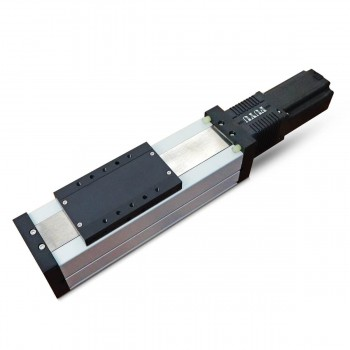1. Introduction to right-angle planetary gearboxes
Right-angle planetary gearboxes are gearboxes used for deceleration or acceleration transmission, with the characteristics of high transmission efficiency, small size, low noise and long service life. Its core structure includes sun gear, planetary gear and inner ring gear. This structure can achieve high-efficiency transmission, and at the same time has high load-bearing capacity and long service life.
2. Working principle of right-angle planetary gearboxes
The working principle of right-angle planetary gearboxes is based on the special structure of planetary gears, and its core lies in the rotation and revolution of planetary gears. The axis of rotation of the planetary gears is not fixed, but is installed on a rotatable bracket, which is called a "planet carrier". The planetary gears can not only rotate around their own axis (rotation), but also rotate around the axis of other gears with the planet carrier (revolution). This movement is similar to the movement of planets in the solar system.
3. Methods for improving the stability of right-angle planetary gearboxes
1. High-quality materials: The right-angle planetary gearbox is made of high-quality materials, with precise gear engagement, low noise, and no obvious wear after long-term use, thereby improving the stability of the equipment.
2. Precision manufacturing process: Through high-precision CNC machining technology, such as gear grinding and gear hobbing, the gear tooth profile accuracy is ensured to reach IT5-IT6 level, so that the gear is evenly stressed during the meshing process, vibration and noise are reduced, and a stable transmission ratio is maintained.
3. Compact structural design: The output shaft of the right-angle planetary reducer is at a 90-degree angle to the input shaft. This design enables the reducer to achieve efficient power transmission in a limited space, which is particularly suitable for occasions with limited space.
4. High transmission efficiency: The multi-stage transmission design of the right-angle planetary reducer enables it to have a higher transmission efficiency, usually up to more than 90%, reducing energy loss and improving the stability and reliability of the equipment.
5. High load-bearing capacity: The multi-point contact planetary gear system design enables the right-angle planetary reducer to have a higher load-bearing capacity, which is suitable for heavy-load occasions and further improves the stability of the equipment.
4. Methods to extend the life of the right-angle planetary gearbox
1. Regular cleaning and maintenance: Keeping the inside of the gearbox clean is the basic condition for extending its service life. Any impurities or dirt entering the gearbox will affect and damage its rotating system, thereby reducing its service life. Regularly clean the oil and dust on the equipment to ensure that the inside of the gearbox is clean.
2. Control the working temperature: Maintaining the normal working temperature of the gearbox can prevent the deformation of parts due to excessive temperature difference, ensure the normal operation of the gears, prevent excessive noise, and thus extend the service life. For gearboxes working in high temperature environments, heat dissipation devices such as radiators or cooling fans can be installed to avoid excessive temperatures that accelerate the failure of lubricants and wear of parts.
3. Reasonable use of lubricants: The use of lubricants is essential to the operation of gearboxes. Delayed use of lubricants or use of inferior oils will cause immeasurable damage to the gearbox. Regularly injecting an appropriate amount of lubricants and ensuring their quality can effectively reduce friction and wear.
4. Avoid overload and impact: Strictly use the rated torque and power of the gearbox to avoid overload operation. In the mechanical system design stage, the workload should be accurately calculated and a gearbox of appropriate specifications should be selected. Reduce the impact load during starting and stopping, adopt a slow and smooth operation method, and protect internal components.
5. Check and replace worn parts: Regularly check the relevant parts of the gearbox, such as oil seals and gaskets, and replace damaged or loose parts in time to ensure the normal operation of the gearbox.
6. Follow the instruction manual: Use the gearbox correctly in accordance with the instruction manual and avoid arbitrary and improper use, which can minimize the damage to the parts in the machine.






